Italy means “la dolce vita.” Italy means pizza. And pasta. And wine. And olives and cheese. Italy means roman monuments, picturesque cities with narrow alleys and tiny local shops. It means touching beautiful villages and vibrant green Tuscan hills. Italy means Venice. And Rome. And soccer.
And there, right next to the spirited locals and the chaotic traffic, between the honking Fiats and the shouting market owners, there it’ll be – the Italy of your dreams. There it’ll be the skyscraping mountain tips of South Tyrol. There it’ll be the colourful villages of the Cinque Terre. Those booming nights at the beach. Those finger licking delicious Italian food. Those hidden gems. Those moments of the dolce vita.
A vacation or a road trip through Italy is one of those amazing, unforgettable experiences in life. But to avoid disappointments all travellers – especially those on the road – should know some helpful facts about this beautiful country and its locals.
In this article, you can find information about the Italian vanlife laws, car sleeping advice, road conditions and rules, and some helpful tips about saving as much money as possible while traveling around Italy. And of course – the best part of all – a guide to all those amazing places which you shouldn’t miss.

Pitigliano
Let’s start with the pleasant part – the “must sees”:
Road Trip Itinerary
ROME. Full stop.
This city is unique, touching and unbelievably beautiful. Italy’s capital is crowded with Roman buildings as the famous “Colosseum”. It seems that behind every corner of the narrow cobblestone alleys you can find another ancient building, a pretty church or a busy piazza. Do you know the movie “Eat, Pray, Love”? Rome looks exactly as in the movie – and it feels like that too.
Sit down in a small restaurant, enjoy a plate of Spaghetti, observe the people walking around, explore some of the beautiful fountains. Flirt. And enjoy life.
Do not miss:
- The Colosseum: you absolutely don’t have to buy a ticket and to wait for hours at the queue. This building is nice from the outside too.
- Fonte di Trevi: the most beautiful fountain! And don’t forget to throw a coin backwards into the water – it brings luck!
- The Spanish Steps: sit down and enjoy a gelato or go for a (expensive) coffee at the famous Café Greco right at the corner – the oldest café in town (but watch out – maybe you’ll sit next to a celebrity. On our last visit we were sitting right next to Karl Lagerfeld ;P ).
- The Vatican: this city is one of those must-sees you’ll never forget in your life. You can explore some of the museums or you can just visit the Peter’s Dome. This enormous cathedral offers a spectacular view from the inside – and an even more spectacular view from the rooftop!
To visit Rome by car is very difficult – or even impossible. Don’t even think about trying it – just don’t do it and save your nerves. The traffic in and around the city is absolutely chaotic. You’re better of parking your car at the airport or the outer train stations and taking the subway or the bus to the city center.
If you’re travelling around by car and you book an accommodation in the city center make sure they offer a parking area (you might have to pay for that).
The most economical accommodations would be the few camping areas in the city, hostels or an Airbnb.
VENICE
There is not a lot to say about Venice. This city is so special and beautiful, that every traveller will be blown away by its beauty. Canals, pretty bridges, medieval castles, cathedrals, towers and an army of singing Gondoliere cruising around with financially strong tourists.
To walk around the lovely canals and streets of Venice is one of those unforgettable vacation memories. Take a seat, enjoy a delicious semi freddo and those `dolce vita moments`.
Do not miss:
- The famous Piazza San Marco and the millions of pigeons
- Rialto bridge
- The near and small islands of Murano and Burano and their glass crafts and artworks
- The most important of all (if you have the necessary budget): take a gondola ride!
Important facts for travellers with their own vehicle:
You can not drive with your own car to the city center! Every traveller is required to leave their car at the airport, in the city of Mestre or at the big parking areas outside of the city center (the costs are approximately 25€ per day). Then you have to take the train, bus or a “vaporetto” (the water busses) to the center.
TUSCANY
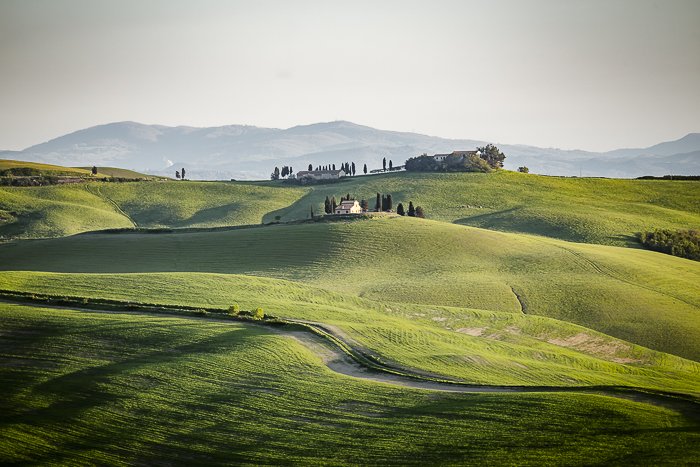
One of the most popular regions of Italy – Tuscany and its gentle green hills, the Mediterranean villas, the cuisine, the wine and all those pretty villages.
Explore the ancient cities of Florence, Siena and Pisa, or do a road trip through the countryside of this spectacular region.
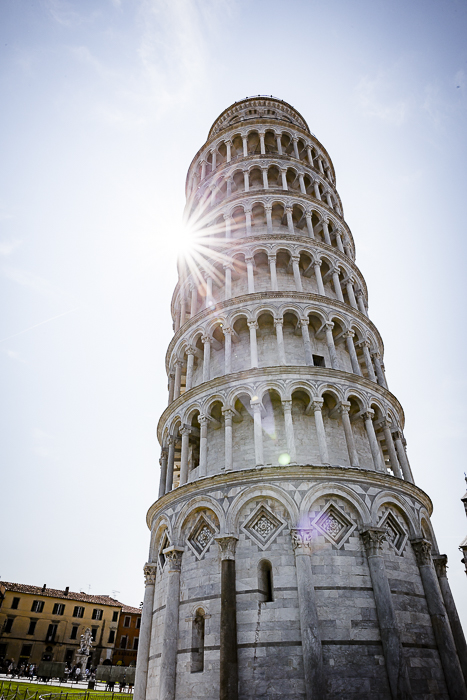
Leaning Tower of Pisa
Do not miss:
- Explore the famous city centers of Florence, Siena, Pisa or Lucca. Cathedrals, churches, towers, castles, piazze, restaurants and shops.
- Tuscan villages: Visit the outstanding Tuscan villages in the middle of the green countryside. San Gimignano and its 14 filigran towers, Volterra and its medieval center (you may know this little town from the movie “Twilight”), the wine mekkas of Montalcino and Montepulciano and the beautiful Pitigliano are some of the most breathtaking villages from this region. The best opportunity to reach those small villages is by car. The roads leading to the villages are some of the most spectacular of Italy – cruisin’ down the dusty streets along gentle Tuscan hills will be one of those unforgettable Italian “dolce vita moments”.
- Terme di Saturnia: One of the spectacular hidden gems of Tuscany. These hot springs with its multiple pools and the about 37°C warm, milky blue mineral water are really unique and – the best of all – totally free! They are located south of Siena, in the tiny village of Saturnia near Pitigliano and Manciano. There is a huge parking area right next to the hot springs (if you’re lucky and you’re travelling during low season, you might be allowed to camp right there at the parking area – park on the lower area right next to the beautiful, warm river flowing out of the hot springs).
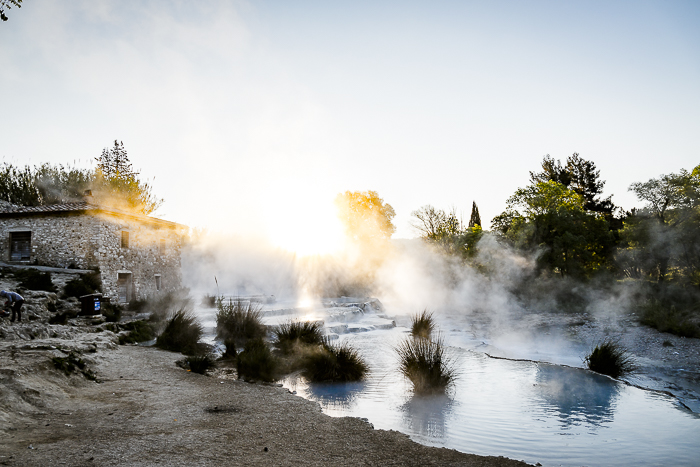
Terme di Saturnia
- Vada: Another hidden gem and one of the most surprising and beautiful beaches of Italy: the dazzling white beach of Vada. This small treasure is located south of Livorno on the eastern coast. The white, soft beach and the crystal blue sea of Vada reminds of the Caribbean. Unfortunately, it has a dark secret: the stunningly white sand is not natural. It’s a result of decades of dumping chemical waste into the sea – right there at the beach of Vada. It is controversial if swimming and sunbathing at this beach is dangerous for your health and body. (If you’re lucky and travelling during low season, the parking area right next to the beach is free. Then you’re also allowed to camp there for free.)

Vada
CINQUE TERRE
There are some of those Italian places that will leave you speechless – the Cinque Terre are some of those. Located at one of the most spectacular coastlines of Europe – at the rugged, steep landscape right up to the cliffs that overlook the sea, the five tiny (!) villages of the Cinque Terre are part of a national park and a UNESCO World Heritage Site.
The five villages are called: Monterosso al mare, Vernazza, Corniglia, Manarola and Riomaggiore. All of them are breathtakingly beautiful. Colorful buildings, narrow, contorted cobblestone alleys, typical shops with local products like cheese, ham and wine, gentle swinging boats and lovely restaurants.
It’s really difficult (and quite expensive) to visit the villages by car. Sometimes the narrow streets leading down to the villages are closed for tourists. If you’re lucky and they are open it’s really difficult to drive (please drive safe and be warned). At the villages, there are only a few, really expensive parking areas out of the town center. Tourists are better of visiting the Cinque Terre is by train. The ordinary italian trains are really cheap and run frequently.
Insider tip 1: if you have time, hike and explore the Cinque Terre national park along the rugh coastline. There are several trails that connect the five villages.
Insider tip 2: if you have time, explore the small village of Portofino about 70km northern of the Cinque Terre (it’s a 1.5 hour drive). This absolutely lovely village is one of the most beautiful in Italy. Narrow alleys, cute restaurants, a quite exclusive clientel and a stunning coastline. (The only bad news: the parking areas are really limited and a bit expensive. If you can, take the public transportation.)
AMALFI COAST
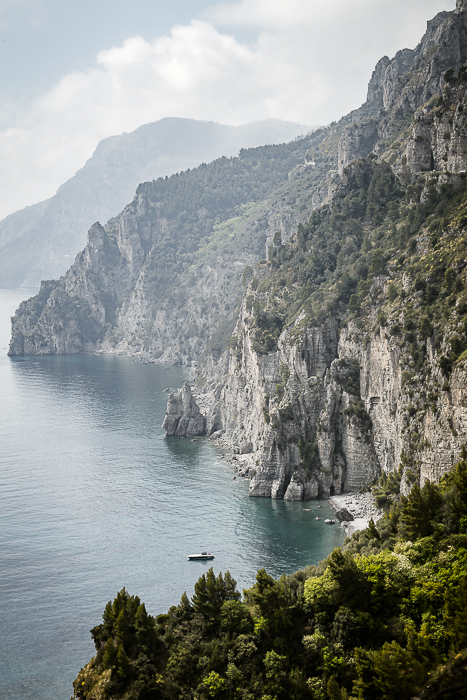
Okay, let’s talk about another very famous region: the stunning Amalfi Coast on the South East side of Italy. Yes, this area is really breathtaking and absolutely beautiful. And yes, there are many, many, many tourists.
This 50km long strip of coastline is one of the most spectacular of Europe and is located south of the city of Naples. Rugh cliffs, crystal blue water, gentle swining boats and wonderful villages. The Amalfi Coast amazes every visitor!
The narrow, curvy street SS163 leads you to the most beautiful parts of the coast. Along the road, you can visit the beautiful viewpoints or some of the colorful villages like Positano (one of the most photogenic of Italy).
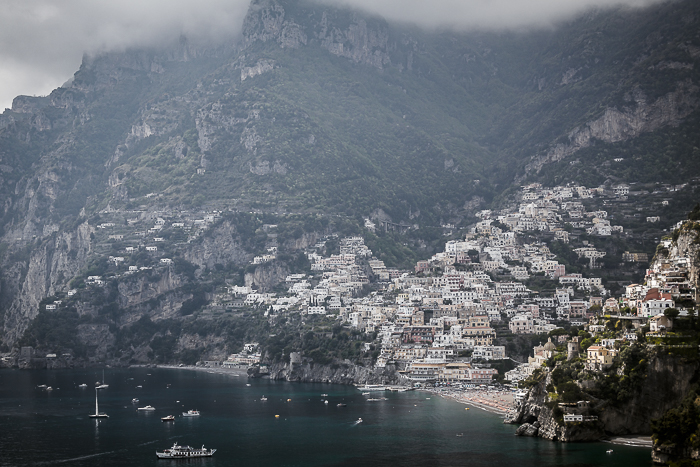
Positano
The bad news: the SS163 is really narrow – it’s really tricky to drive there with a big vehicle. Along the road and at the villages are only a few (expensive) parking areas – if you’re travelling during peak season you might come in the early morning to snatch one of the precious parking lots.
Insider tip: if you have time and you’re travelling around the Amalfi Coast don’t miss the near attractions of Pompeii, Naples and Mount Vesuvius!
Right next to the chaotic but lovely city of Naples (don’t miss the market and the tiny alleys full of shops in the city center!), you can visit the ancient city of Pompeii. The UNESCO World Heritage Site was buried under 5m of volcanic ash and pumice in the eruption of Mount Vesuvius in AD 79. Today visitors can explore the ruins of the temples and roman houses. (The entrance fee is about 15€.) There is a pretty campsite right next to the ruins.
Insider tip: if you’re travelling by car it’s cheaper to park your vehicle at the campsite (just for day parking) than to buy a ticket at the ordinary parking areas around Pompeii. Good news if you’re travelling by public transportations: there is a train station right next to the entrance of Pompeii (the train to Naples city center costs about 3€ per person).
If you ever wanted to conquer a volcano, here is your chance! The beautiful strato volcano Mount Vesuvius located about 9km east of Naples is easily scalable. From the parking area, you can do an 860m long steep hike to the top of the volcano where you can enjoy a wonderful view over Naples and the coast. (The entrance fee is about 10€ + 5€ for the parking lot along the road).
Attention: during summer the temperatures can be really, really hot! Don’t forget to carry plenty of water, sunscreen and a hat!
Oh, and maybe the most important advice for travellers in this area: don’t drive in Naples! Even if you’re a good driver – don’t try it! Don’t even think about trying it! It’s more chaotic than words could ever describe. Stay save and take the public transportations.
DOLOMITES
Okay, where should I start… The Dolomites and the South Tyrolean region are one of the most spectacular landscapes of Italy. Absolutely stunning and gorgeous with a lovely mix of incredible mountain peaks, unforgettable hiking trails and the best food ever. This area is a perfect destination for every outdoor fan and nature lover. And I’m writing this not because it’s my home. I’ve travelled the world, but honestly, there are only a few places that are as breathtakingly beautiful as the Dolomites.
Located at the northern most part of Italy at the border to Austria, this famous region offers a wide variety of attractions. You can discover pretty city centers and tiny mountain villages with their traditional wooden houses. Or you go outside and explore the spectacular landscape – hiking, mountain biking, climbing, horse riding …
The most outstanding spots in the Dolomites:
- Lago di Carezza: this breathtaking, small mountain lake situated at the foot of some of the most stunning mountain tips has a bright green colour during the day. In the early morning or the late afternoon the water reflects the beautiful mountain behind the lake.
- Alpe di Suisi: this popular mountain area with its huge, alpine meadow full of jingling cows and absolutely stunning mountain peaks is one of the well-known attractions of South Tyrol. There are a bunch of traditional mountain huts where you can enjoy a traditional meal (do not miss a lunch at the “Gostner Schwaige”) and a lot of hiking trails.
- Geisler/ Odi: the multiple mountain tips of the Odi are some of the most remarkable of the Dolomites. Do not miss the popular “Adolf Munkel” hike (this easy roundtrip takes about 2 hours) and go for a lunch at the “Geisleralm” right in front of the spectacular mountain tips (the food is delicious!).
- Lago di Braies: you might already know this beautiful mountain lake from Instagram. Every year its beauty attracts a lot of visitors and landscape photographers. Do not miss: take a boat ride at the lake!
- Tre Cime di Lavaredo: those 3 mountain peaks are one of the most famous and remarkable of the region. To circuit the mountain tips it takes about 4 hours.
Fun fact: in South Tyrol, the majority of the people speak German (or let`s say a “badass german dialect”). Everybody grew up at least bilingual.
Helpful Tips
For drivers:
- First of all: in Italy, you have to drive on the right side of the street.
- In general you are allowed to drive when you’re 18 (please ask your rental car company if they have any restrictions about the driver’s age or the need of an international driving license)
- Italy has a strict drink-drive limit of 0.5mg of blood alcohol (this means you can not drink more than one glass of wine without risking going over the limit)
- The big highways are called “autostrada” (and are marked with an “A” and a number – for example “A22”). On every autostrada you have to pay a toll. The system goes like this: you drive to the beginning of an autostrada. At the toll gate choose one of the lanes (don’t use the yellow lane called “telepass” – it’s for drivers with an automatic payment method). Take the ticket at the counter. Drive along the autostrada until you’ve reached your exit. At the toll gate of your exit choose one of the lanes (not the yellow one! Normally there are lanes where you can pay directly at an operator or with card). Show your ticket. Pay the toll fee and continue on your journey. Isn’t it easy? (summarizing: you have to pay for every highway-kilometer you drive – the less highway drives the less you pay.)
- Attention: many highways and busy roads are a bunch of speed cameras! (sometimes they are hidden)
- In many cities and villages, you can find “restricted traffic zones” (called “zona traffico limitato”). It means that only authorized people can use the road. Sometimes the restricted traffic signs are just simple white signs – you have to be really attentive to see them! If you pass one of those roads you will probably get a ticket … and it can be expensive.
- Try to avoid driving in the big cities like Rome, Milan or Naples – especially Naples! It’s better to not even think about driving there! The traffic is ABSOLUTELY chaotic (and in Naples probably dangerous too). You will rescue your nerves if you take the public transportations.
- At some parking garages, you have to leave the key from the car at the operator after parking your vehicle (or they park it for you). It’s quite a strange feeling to leave them with your keys… Most of the time the car is safe, but it’s always better to not leave such expensive or important stuff inside of the car.
For food lovers:

Real pizza of Naples
- The most important insider tip first: if you’re searching for a nice restaurant or bar, go where all the locals stay! The more crowded the better. Even if the establishment doesn’t look as pretty. Even if it looks chaotic. The locals wouldn’t ever stay at a bad restaurant. Follow them! (And don`t stay at an empty restaurant. There is always a reason for the emptiness … )
- Many of the Italian restaurants charge a “fixed service fee”. Normally it’s about 1-2€ per person. Often you get free bread. On the bill, the fee will be called “coperto”.
- At the bars, the prices for the beverages can vary. Mostly the drinks at the counter are cheaper than the served drinks at the tables (because of this, many of the Italians drink their Espresso right at the counter).
- At really famous and popular places and city centers (like the Piazza San Marco in Venice or the Spanish Steps in Rome) the restaurants and bars are unbelievably expensive (and often low quality). A normal Cappuccino could cost about 15€ (normally not more than 3€)! Better: try to find a restaurant or bar at the next corner or side street – normally the prices there will be way cheaper.
Money saving tips for Italy:
- Do not rent sunchairs or umbrellas at the beaches (it’s cheaper if you buy an umbrella by your own and take a seat right in front of the rented chairs or at a public beach. It costs you nothing.) The bad news: if you rent sunchairs they are protected and monitored. If you just lie on the sand you have to take care of your stuff on your own.
- Do not come in high season! Hotels, resorts, campsites and even parking areas will be way cheaper in the low season than in the peak season (parking areas may even be free in low season).
- Buy your food in the grocery stores and supermarkets instead of staying at restaurants. Of course, the Italian restaurants are the best! But if you’re travelling with a low budget it might be better to buy snacks and light lunches at the supermarket. In general, the quality of the products is really high! In the grocery store,s you can find everything from the best wines (the same as in the restaurants!), cheese, sausages and ham, fresh bread, pastries and salads. The only bad news: in Italy, you can’t find supermarkets as big as in the States or in Australia (we do not have Walmart or something similar). There are big grocery stores and chains but they don’t have those dimensions. The cheapest stores are LIDL and Eurospin. Higher in quality but also more expensive: Eurospar, Coop, Despar, Interspar.
- If you’re travelling on a low budget and you’re looking for cheap but traditional and local souvenirs you might find something in the grocery stores. How about a bottle of Italian wine? Or cheese like Parmiggiano Reggiano (the world’s best parmesan)? Or olives? Or olive oil (the best is extra virgin and cold pressed olive oil)? Or a bottle of balsamico vinegar? You see there are a lot of things your loved ones at home would love. Just make sure you’re allowed to bring those souvenirs with you on your flight back home.
- Another good money saving tip: try to avoid the highways where you have to pay a toll fee. If you’re travelling around and you’re spending maybe a few weeks here in Italy, you will probably have to pay hundreds of Euros just for the highway toll. Take the slower state roads, enjoy the landscape and save money.
For campers and van life:

Ok, vanlife is great. You love it. We love it. Everybody loves it. Camping is great. We all love it too. The good news: in Italy you can camp and you can vanlife. But there is some bad news for every smart savers out there: free/ wild camping is generally NOT legal in Italy. Full stop. Only if you have the permission from the landowner or the local police you’re allowed to do it and that’s pretty unlikely.
In every bigger town, you can find nice campsites. Sometimes they are really simple and cheap, sometimes they offer swimming pools and private beaches and cost more. In general: the more famous and popular a place the more expensive the campsite will be.
If you’re looking for some low budget or even free camping opportunities, here are some helpful tips and things you should know:
- The first and maybe the most important fact: whilst free/wild camping is illegal, sleeping in your car (to refresh your driving capability) is allowed. You can sleep in your car up to 8 hours. Just make sure you park your vehicle properly and don’t put your camping chairs out. If the police knock on your windows, say that after a long journey you were to sleepy to drive and didn’t want to risk an accident. Say that you will just sleep a few hours and then leave. And then please really leave! If the police officer meets you another day at the exact place, you`ll have a problem…
- The easiest and most economical “campsites” for vanlifers are highway rest areas. You can find them along the big highways in Italy. You’re allowed to sleep there in your vehicle for free – but you’re not allowed to camp! So don’t leave your chairs and camping table outside of the van. The rest areas offer huge parking areas (for trucks and for cars), restaurants, shops, fuel stations, toilets and often cheap showers. Normally the restaurants and bars are open 24/7 (there you can drink the best Italian coffee! Because the coffee machine is running the whole day.) To sleep at the rest areas is generally safe. Sometimes it’s just a little bit noisy and busy during the day.
- In Italy, there are official motorhome and camper van rest areas called “aree di Sosta”. The facilities and the prices can vary (in general they are really cheap). You are not allowed to stay more than 24 hours and normally you’re not allowed to put any camping equipment outside of your vehicle.
- Another opportunity to “free” camp: if you find a restaurant with a large parking area suitable for overnight stopping, you may find the owners are happy for you to park overnight, assuming you eat at the restaurant.
- If you’re travelling during low season you’ll probably find some free campsites. If you’re lucky you can stay for free at parking areas or directly at the beaches.
- For everybody searching for quiet and uncrowded free camp spots: search far away from any villages. You may find some suitable camp spots in the forests or countrysides, in the mountains or uninhabited farmlands. Please don’t forget: do not leave anything behind except your footsteps and please follow the local fire restrictions.
- The best and cheapest place to buy camping equipment is the huge Decathlon stores. You can find them in every big town. Generally, you can find everything from tents to camping chairs, clothes and sleeping bags, camping cutlery, chairs, tables, stoves… Normally they offer only one type of camping gas (if you need another sort of camping gas you may find some at the warehouse called “OBI” or small hardware stores. For propane gas, you may have to ask at fuel stations.
Summarizing I can say: even as an Italian vanlifer, it’s really hard to find free/wild camp spots. As a foreign tourist, it’s even harder. But it isn’t impossible. Seach your camp spots during daylight, try to avoid dubious areas in southern Italy, plan in advance, and ask other campers. And the most important tip of all: even if it’s hard to travel Italy on a low budget, please don’t forget to enjoy this wonderful country and catch some of the Italian dolce vita.
Article written by Valeria – check out her stunning images on Instagram at @valeria.pixner






Thanks for this information! I am planning to elope in Italy with my boyfriend next summer and literally jumping in a rented Van the next day and travel for a week or so. Any ideas on the best course of action?